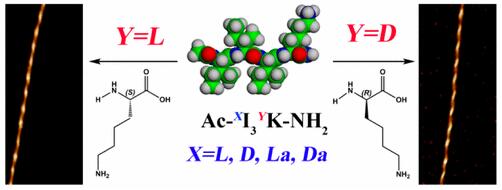Recently, the research group of prof. Wang Jiqian and prof. Xu Hai from Center for Bioengineering and Biotechnology made great progress in the research of Molecular Chirality's Affects on Self-assembly. The finding Left or Right: How Does Amino Acid Chirality Affect the Handedness of Nanostructures Self-Assembled from Short Amphiphilic Peptides was published on JACS.

Peptide and protein fibrils have attracted an enormous amount of interests due to their relevance to many neurodegenerative diseases and their potential applications in nanotechnology. Although twisted fibrils are regarded as the key intermediate structures of thick fibrils or bundles of fibrils, the factors determining their twisting tendency and their handedness development from the molecular to the supramolecular level are still poorly understood. In this study, three pairs of enantiomeric short amphiphilic peptides have been designed: L I3 L K and DI3 DK, L I3 DK and DI3 L K, and LaI3 L K and DaI3 DK, and investigated the chirality of their self-assembled nanofibrils through the combined use of atomic force microscopy (AFM), circular dichroism (CD) spectroscopy, scanning electron microscopy (SEM), and molecular dynamic (MD) simulations. The results indicated that the twisted handedness of the supramolecular nanofibrils was dictated by the chirality of the hydrophilic Lys head at the C-terminal, while their characteristic CD signals were determined by the chirality of hydrophobic Ile residues. MD simulations delineated the handedness development from molecular chirality to supramolecular handedness by showing that the β-sheets formed by L I3 L K, LaI3 L K, and DI3 L K exhibited a propensity to twist in a left-handed direction, while the ones of DI3 DK, DaI3 DK, and L I3 DK in a right-handed twisting orientation.
The research recieved supports from NSFC (Natural Science Foundation of China). The group of biological interface and biological material led by prof. Wang Jiqian and prof. Xu Hai has made a systematic study of Self-Assembly from Short Amphiphilic Peptides and has published 40 related papers on Biomaterials、Chem. Matter.、ACS Appl. Mater. Interfaces、Chem Comm.、Langmuir、Biomacromolecules、Chem. –Eur. J.、Soft Matter、Chem. –Asian J.
See more about the research: http://pubs.acs.org/doi/abs/10.1021/jacs.7b00847
Source: UPC News Center (March 14, 2017)